Pros
Cons
Introduction
Overall Design
{{section_header}}{{section.name}}{{/section_header}}
The Panasonic TC-P37X2 is a very cookie-cutter design, and would be hard to pick out in a line-up. The plastic used in the frame feels cheap and shows fingerprints easily. However, it has just enough curve to keep it from looking too boxy.
Front
{{section_header}}{{section.name}}{{/section_header}}
The Panasonic TC-P37X2 is a standard-looking TV with a high-gloss finish. Be aware that these types of finishes are finger-print magnets.

Back
{{section_header}}{{section.name}}{{/section_header}}
The back of the TV is a matte black plastic. All the ports here are gathered in one corner for easier access.

Sides
{{section_header}}{{section.name}}{{/section_header}}
The Panasonic TC-P37X2 is not terribly skinny, as you can see in the photos below. However, plasmas simply can't get as thin as those newer "ultrathin" LED-lit LCDs. There's enough room for ports on one side, and onboard controls on the other.

Stand/Mount
{{section_header}}{{section.name}}{{/section_header}}
The stand that attaches to the bottom of the Panasonic TC-P37X2 feels quite cheap, but the TV panel is light enough that it doesn't require much. The stand does not allow the TV panel to swivel, which is unfortunate. That can be a very useful feature for certain types of viewing situations.

Controls
{{section_header}}{{section.name}}{{/section_header}}
The Panasonic TC-P37X2's onboard controls are located on the right side, towards the bottom.

Remote Control
{{section_header}}{{section.name}}{{/section_header}}
The remote control that ships with the Panasonic TC-P37X2 is compact and lightweight. We like how well-labeled the buttons are, but the key travel (how far down you have to push the button) is too far and creates a sluggish interface.

In the Box
{{section_header}}{{section.name}}{{/section_header}}
The Panasonic TC-P37X2 ships with the stand, remote control, batteries, assorted documentation, and iPod dock (with attached cable).
Black Level
{{section_header}}{{section.name}}{{/section_header}}
The Panasonic TC-L37X2 did not impress us with its black level. As we've seen before, Panasonic is just not a leading LCD TV maker. They're strength is in plasma displays. You can see from the chart below how Sony and Samsung performed much better. More on how we test black level.
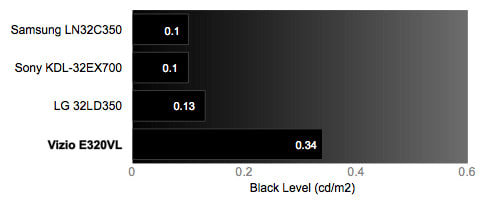
Peak Brightness
{{section_header}}{{section.name}}{{/section_header}}
The peak brightness was pretty terrible, measuring only 167.34 cd/m2. Granted, you can get the peak brightness higher, but it comes at the cost of seriously compromised color performance (learn more). We consider color performance more important, and we're willing to take a hit on brightness. Or better yet, find a different TV. More on how we test peak brightness.
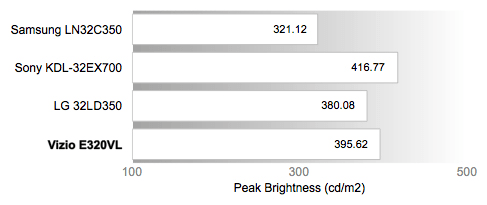
Contrast
{{section_header}}{{section.name}}{{/section_header}}
The Panasonic TC-L37X2 has a serious compromise. You can either leave the menu's contrast setting high, which helps the TV's contrast ratio but, again, kills color performance. Or you can lower contrast setting to rescue the color performance, but lose a lot of contrast ratio. There's always a little trade-off, but a TV should never make you choose between two such extremes.
Contrast Ratio with High Contrast Setting

Below is the contrast ratio with the contrast set to 90, rather than 68. It hurts contrast ratio quite a bit, but helps immensely with color performance. More on how we test contrast.

Tunnel Contrast
{{section_header}}{{section.name}}{{/section_header}}
The Panasonic TC-L37X2 had no problems maintaining a consistent black level, regardless of how much or how little black was on the screen. More on how we test tunnel contrast.
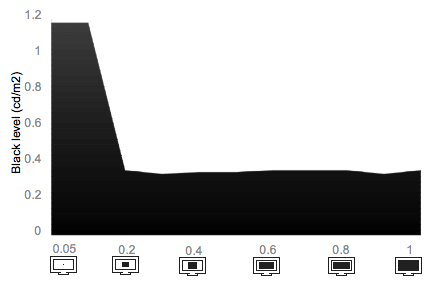
White Falloff
{{section_header}}{{section.name}}{{/section_header}}
The Panasonic TC-L37X2 also had no problems with maintaining a consistent peak brightness. More on how we test white falloff.
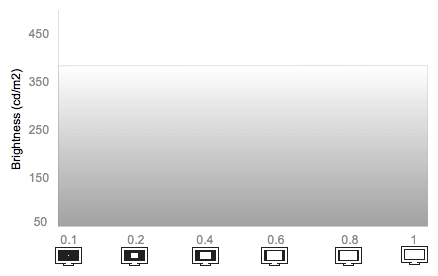
Uniformity
Greyscale Gamma
{{section_header}}{{section.name}}{{/section_header}}
The greyscale gamma looks at how well a TV transitions from black to white. The chart below tells you a lot about the performance. Ideally, we want a smooth line. The bumps that you see below are indications that the TV might be screwing up what should be a smooth, gradated transition. There's also the slope of the line to consider. An ideal slope is somewhere between 2.1 and 2.2. This Panasonic TC-L37X2's slope of 2.48 is a bit steeper, but not too bad compared to most TVs. More on how we test greyscale gamma.
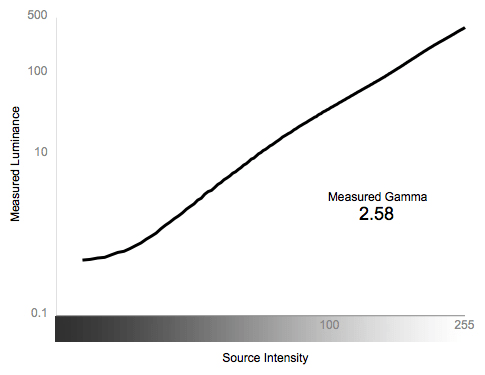
Color Temperature
{{section_header}}{{section.name}}{{/section_header}}
The Panasonic TC-L37X2 showed some slight issues with maintaining a consistent color temperature. As you can see from the chart below, as it dips into the shadows, the color temperature cools considerably. But because it's only a small portion of the spectrum, we didn't score it too harshly. More on how we test color temperature.

RGB Curves
{{section_header}}{{section.name}}{{/section_header}}
As we stated earlier in the review, the Panasonic TC-L37X2 forces you to choose a poor contrast ratio in order to get acceptable color performance, or better contrast ratio with terrible color performance.
Look at the charts below. This first performance chart is the result of using the default contrast setting, which was relatively high. The red and blue channels are awful, and can display no details between the mid-tones and the peak brightness.
RGB Curves with Contrast Set Higher

The second performance was taken with the contrast setting fairly low, and as you can see, the curves are smooth and uniform. More on how we test RGB curves.

We consider color performance to be more important that contrast ratio, though manufacturers may try to convince you otherwise with unrealistic, million-to-one contrast ratios. But at least you now know what your options are with the Panasonic TC-L37X2, should you choose to purchase it.
The color strips below are digital recreations of the performance (based on the better color performance).
Motion Performance
{{section_header}}{{section.name}}{{/section_header}}
Motion Smoothness (6.0)
The Panasonic TC-L37X2 did pretty well in our motion tests. Objects moving across the screen were not bogged down with any more judders and flickers that we see on most LCD TVs. Unfortunately, the X2 series does not have the same processing feature, Motion Picture Pro 4, that Panasonic offers on the D2 and other series. Those can be useful in smoothing out motion, though they frequently come at the cost of increased artifacting.
Motion Artifacting (5.0)
The Panasonic TC-L37X2 did not suffer from egregious artifacting, but there was noticeable color trailing and judders in moving objects. We also suspect that the TV's extremely high oversharpening (which cannot be turned off) contributed to some of these problems, because high-contrast patterns would create additional problems. More on how we test motion performance.
3:2 Pulldown & 24fps
{{section_header}}{{section.name}}{{/section_header}}
The Panasonic TC-L37X2 showed no serious problems with native 24fps content, such as what you get from most Blu-Ray movies. In order to get the best performance, you must put the 3:2 pulldown setting in "auto" mode. If it's off, you're going to get a lot of stutter. More on how we test 3:2 pulldown and 24fps.
Resolution Scaling
{{section_header}}{{section.name}}{{/section_header}}
The Panasonic TC-P37X2 has a native 720p (1280 x 720p) resolution, but much of the content you throw at it will be of higher or lower resolutions. It's up to the TV's internal processing to rescale the image. Unfortunately, the TC-P37X2 does not appear to be very good at this task. It's hard to tell if it's actually a problem with the scaling, per se, because we saw a lot of the same problems in its native resolution. Anyway, the details are below. More on how we test resolution scaling.
480p
The 480p content we tested lost 2% on all sides of the screen to overscan. There were also obvious Moire patterns that appeared when we displayed high-frequency, high-contrast patterns. This is very unusual, because 480p resolution should pose no problems for a decent HDTV.
1080i
The 1080i content we looked at also lost 2% all around to overscan and had huge problems with Moires in high-frequency patterns.
1080p
The 1080p content was just as bad as the 1080i.
Formats
{{section_header}}{{section.name}}{{/section_header}}
The Panasonic TC-P37X2 has a native 720p (1280 x 720) display, but can handle all standard NTSC resolutions, including 1080i and 1080p. The TV simply downscales the picture to fit on the screen.As we said on the previous page, though, the TV is doesn't scale any of them particularly well, and it doesn't even display its native resolution without overscan loss and Moires.
Viewing Angle
{{section_header}}{{section.name}}{{/section_header}}
The viewing angle on the Panasonic TC-L37X2 was rather good for an LCD TV. As you can see from the chart below, it far exceeded the performance of the similarly priced Samsung and Sony (though those TVs were superior in most other respects). While not quite as wide as what you'd get with an average plasma display, we're still impressed.

Reflectance
{{section_header}}{{section.name}}{{/section_header}}
The Panasonic TC-L37X2's screen takes on a soft, diffused glow when hit with a strong ambient light. This is usually better than the sharp, mirror-like reflections that plagues some LCD TVs, so for that we're thankful. However, depending on the angle of the light and position it takes on your screen, this kind of glow may prove even more distracting.
Video Processing
{{section_header}}{{section.name}}{{/section_header}}
The Panasonic TC-L37X2 offers most of the same video processing features found in its other LCD TVs, minus "Motion Picture Pro 4," which smooths out moving objects while creating a host of other problems. We don't miss it all that much.
Calibration
{{section_header}}{{section.name}}{{/section_header}}
The Panasonic TC-L37X2 proved to be a tough TV to calibrate, and we were forced to run full testing through few different scenarios in order to get the full story. The problem is that the contrast setting in the menu defaults to a value of 90. We could tell with our naked eye that this was way too high, and it was killing detail in the highlights. But when we lowered the contrast, it had a severe effect on screen brightness. Now, manufacturers frequently label a setting one thing, like contrast, while it actually alters a number of PQ elements other than contrast – perhaps a little brightness and a little gamma curve. But it's rare that we see such a dramatic effect. When we lowered the contrast setting to a value of 68, in order to retrieve some color detail, the brightness was drastically reduced, which affected the TV's overall contrast ratio.
Some people consider contrast ratio to be a TV's most important spec. We disagree, and put color performance first. Usually, we can find a nice balance between the two, but not with the Panasonic TC-L37X2. Therefore, we presented the test results for color and contrast as they occurred under both settings. The table below is the calibration for best color.
Any processing features not listed should be assumed disabled.

All of our calibration is done in conjunction with the DisplayMate software.
](http://www.displaymate.com/)
Video Modes
{{section_header}}{{section.name}}{{/section_header}}
The Panasonic TC-L37X2 offers five preset video modes if you don't want to be bothered with all this calibration business. We recommend putting it in Cinema mode, if you plan on doing nothing else.
Ergonomics & Durability
{{section_header}}{{section.name}}{{/section_header}}
The remote that ships with the Panasonic TC-P37X2 is perfectly serviceable, but not the most comfortable. The buttons are clearly labeled and easily defined by shape, but you have to push down pretty hard on them to get a response sometimes.
Button Layout & Use
{{section_header}}{{section.name}}{{/section_header}}
The button layout is smartly grouped, with the menu controls near the top, volume and channel up/down buttons in the center, and 0-9 keys towards the bottom. Importantly, the volume button can easily be distinguished by touch, so when the commercials come screaming on at 2 am, you'll be able to silence them quickly.
Programming & Flexibility
{{section_header}}{{section.name}}{{/section_header}}
The remote can be used to control select Panasonic AV devices that use the Viera Link system. That's when you'll be able to take advantage of those playback controls at the bottom of the remote. The remote, however, is not universally programmable for other devices.
Connectivity
{{section_header}}{{section.name}}{{/section_header}}
Input Ports (5.5)
The Panasonic TC-L37X2 has enough ports to get you started with a decent home theater system. There are 3 HDMIs, which should cover most of your newer devices, along with 2 composite AV inputs for older devices. There's only 1 component AV input, though, so be aware of what you want to connect before you buy.

The ports are split into the back and side. The back houses most of the ports, including the connection for the iPod dock. The side is intended for inputs you want to swap quickly, including SD/SDHC cards.
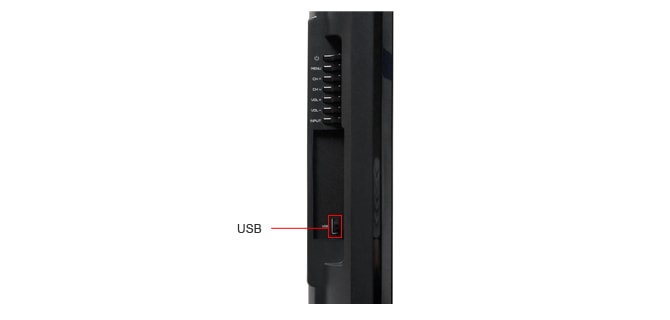
Output Ports (1.0)
The Panasonic TC-L37X2 has just one output port, a digital audio out. There is no analog audio out, so those looking to connect the TV to older sound systems are out of luck.
Other Connections (0.0)
The Panasonic TC-L37X2 has no ethernet or WiFi connectivity, and doesn't support DLNA.
Media (4.0)
One of the Panasonic TC-L37X2's more prominent features is an included iPod dock, which plugs into the back of the TV via an attached cable. With it, you can watch videos and listen to music stored on your iPod. More details "later": in the review.
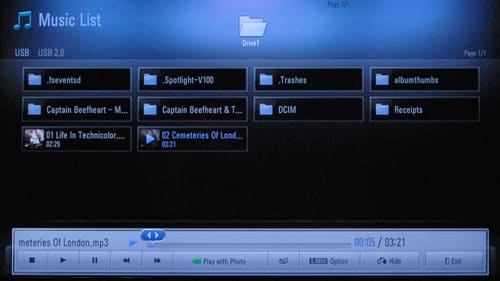
{{product.manufacturer_specs['Connectivity Tour Image 3']}}
Placement
{{section_header}}{{section.name}}{{/section_header}}
The ports on the Panasonic TC-L37X2 are well-positioned and easily identified thanks to good labels. Panasonic has never sacrificed clear labeling for style on its TVs.
Audio Quality
{{section_header}}{{section.name}}{{/section_header}}
The Panasonic TC-L37X2's built-in speakers is strictly perfunctory. They'll do the job, but if you're an avid movie watcher, you'll probably want to invest in a separate audio system. Be aware that this TV has a digital audio output, but not an analog audio out, so you may not be able to connect to older systems.
Menu Interface
{{section_header}}{{section.name}}{{/section_header}}
The menu on the Panasonic TC-L37X2 is more or less the same on all entry and mid-level Panasonics. No matter where in the menu you are, you can always see the main navigation icons in the left column. It's simple and self-evident to use. Our only complaint is that the key travel on the remote control's buttons makes the whole process a bit sluggish.

Instruction Manual
{{section_header}}{{section.name}}{{/section_header}}
The instruction manual that comes with the Panasonic TC-L37X2 is comprehensive enough to answer most of your questions. There's a table of contents in the front, but no alphabetical index in the back. As such, you might have a tough time finding the information you need quickly. It might be easier to download the digital version and use the search function on your computer. You can find the Panasonic TC-L37X2's manual online here.

A manual for so many TV models, they have to be further categorized by type.
Internet Features
{{section_header}}{{section.name}}{{/section_header}}
The Panasonic TC-P37X2 does not have any streaming content features, nor does it support DLNA home theater networks.
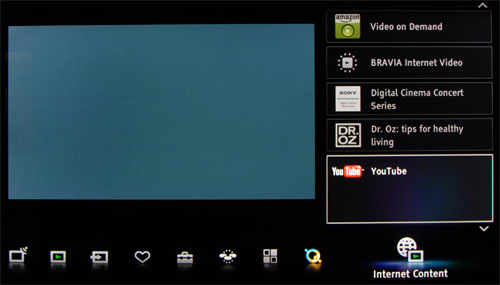
Local Media Playback
{{section_header}}{{section.name}}{{/section_header}}
The Panasonic TC-P37X2 can display photos from either SD/SDHC card slots or an iPod. The photos can be displayed as thumbnails, full screen, or in a slideshow. If you're making a slideshow, you can play music that's stored on the same device.

The Panasonic TC-P37X2 will play back music or video clips from SD/SDHC card slots or the iPod dock. The interface is pretty basic, and it sure ain't pretty, but it works. The TV's remote control buttons (play, pause, rewind, etc...) are used for individual clips, and the nav buttons are used to pick your way through the onscreen menus.

The included iPod dock has a relatively short cable, and it's a proprietary fit, so don't expect to be able to extend it. However, it feels sturdy enough and will charge the battery while it's connected.

Other Media
{{section_header}}{{section.name}}{{/section_header}}
The Panasonic TC-P37X2 does not support any other types of media.
Power Consumption
{{section_header}}{{section.name}}{{/section_header}}
The Panasonic TC-P37X2 will cost approximately $15.68 per year in electricity, depending on your region and the level at which you set the TV's backlight. See the table below for how backlight can raise and lower that cost.
Overall, $15.68 is really not that much money. You can see how much more a plasma display like the Samsung PN42C450 will run you.
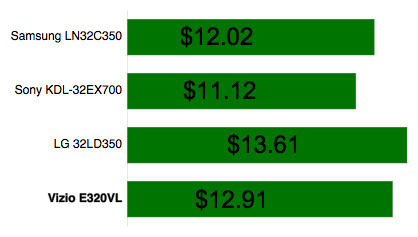
Value Comparison
{{section_header}}{{section.name}}{{/section_header}}
The Samsung PN42C450 seemed to exacerbate all the things we don't love about plasmas. There's that distinct mosquito flicker in the picture, and the performance overall was compromised. Samsung is an LCD manufacturer, first and foremost, and an entry-level plasma like this is not a great purchase. Conversely, Panasonic is primarily a plasma maker, and an entry-level LCD like TC-L37X2 is not a good example of the best that Panasonic can offer.
Blacks & Whites
{{section_header}}{{section.name}}{{/section_header}}
The Panasonic TC-L37X2 could not get nearly as black as the Samsung PN42C450. But, as a plasma display, we expect it to be better. However, the Panasonic TC-L37X2 was particularly bad at contrast ratio and was easily beaten. For more details about how to get better contrast ratios on the Panasonic TC-L37X2, jump here.

Color Accuracy
{{section_header}}{{section.name}}{{/section_header}}
The Panasonic TC-L37X2, when calibrated correctly, offers great color performance. The Samsung PN42C450 was not quite as good.
Motion
{{section_header}}{{section.name}}{{/section_header}}
The Samsung plasma display was able to better portray motion, as is frequently the case.
Viewing Effects
{{section_header}}{{section.name}}{{/section_header}}
As a plasma display, the Samsung PN42C450 offers a far wider viewing angle than the Panasonic TC-L37X2. However, the Panasonic was really quite good, for an LCD screen.
Connectivity
{{section_header}}{{section.name}}{{/section_header}}
The Panasonic TC-L37X2 has an included iPod dock, which is a nice touch but not necessarily something everybody needs. The Panasonic also offers a SD/SDHC card slot. However, the Samsung has an analog audio out.
Value Comparison
{{section_header}}{{section.name}}{{/section_header}}
The LG 32LD450 is not a perfect TV, but we like what it offers for the price. The color performance is great, though it seems to come at a cost to contrast ratio and black level. However, it was far less compromised than the Panasonic TC-L37X2. We definitely prefer the LG in this match-up.
Blacks & Whites
{{section_header}}{{section.name}}{{/section_header}}
The LG 32LD450 had a very disappointing performance in black levels and contrast ratio. However, the Panasonic TC-L37X2 was worse. For more details about how to get better contrast ratios on the Panasonic TC-L37X2, jump here.

Color Accuracy
{{section_header}}{{section.name}}{{/section_header}}
The LGs we've reviewed this year have all performed extremely well in our color tests. The Panasonic TC-L37X2 could not beat it, though it came close.
Motion
{{section_header}}{{section.name}}{{/section_header}}
The Panasonic TC-L37X2 proved better in our motion tests than the LG 32LD450, but the margin is small.
Viewing Effects
{{section_header}}{{section.name}}{{/section_header}}
The Panasonic TC-L37X2 offers a surprisingly good viewing angle, for an LCD display. It beat the LG 32LD450 handily.
Connectivity
{{section_header}}{{section.name}}{{/section_header}}
The LG 32LD450 is limited by only 2 HDMIs, so it may not make a great choice for a living room home entertainment hub.
Value Comparison
{{section_header}}{{section.name}}{{/section_header}}
The Sony KDL-32EX700 is a more expensive TV, but the money is well spent on a far superior picture quality. Better contrast and black levels, smoother motion, better resolution scaling, and support for streaming content and DLNA make for a high-value TV.
Blacks & Whites
{{section_header}}{{section.name}}{{/section_header}}
The Sony KDL-32EX700 offers excellent black level and contrast ratio, far, far exceeding the Panasonic TC-L37X2. For more details about how to get better contrast ratios on the Panasonic TC-L37X2, jump here.

Color Accuracy
{{section_header}}{{section.name}}{{/section_header}}
The color performance of the Panasonic TC-L37X2 slightly outmatches the Sony 32EX700, but the margin is not huge.
Motion
{{section_header}}{{section.name}}{{/section_header}}
The Sony 32EX700 offers much better motion performance than the Panasonic TC-L37X2, in part because it has a motion processing feature that allows you to smooth out the jaggies. The effect creates some weird side effects and it's not to everyone's taste, but it's good to have options.
Viewing Effects
{{section_header}}{{section.name}}{{/section_header}}
The Panasonic TC-L37X2 easily outclassed the Sony 32EX700 when it came to viewing angle.
Connectivity
{{section_header}}{{section.name}}{{/section_header}}
The Sony 32EX700 has an additional HDMI, but only one composite AV input for older devices. It's important to know what you want to plug into a TV before you buy it.
Conclusion
The Panasonic TC-L37X2 ($649 MSRP) biggest flaw is that in the calibration process, you're forced to choose between great color performance at the cost of terrible contrast ratios, or passable contrast ratios at the cost of awful color performance. Calibration is always a trade-ff, of sorts, but no TV owner should be forced to choose between such distasteful extremes.
There are a few things we liked in the TC-L37X2. When the color performance is good, it's very good. It offers great viewing angle, and the iPod dock is an enjoyable add-on. Overall, though, we simply can't recommend this TV.
Model Series Comparison
{{section_header}}{{section.name}}{{/section_header}}
The Panasonic X2 series is an entry-level set of LCD TVs with a 720p resolution. All three models come with an iPod dock and SD/SDHC card slot, both of which allow you to play photos, music, and videos right on the TV.
Photo Gallery
{{photo_gallery "Front Tour Image", "Back Tour Image", "Sides Tour Image", "Stand Photo", "Controls Photo", "Remote Control Photo", "Connectivity Tour Image 1", "Connectivity Tour Image 2", "Connectivity Extra Photo", "Menu Main Photo", "Menu 2 Photo", "Internet Features 1 Photo", "Internet Features 2 Photo", "Internet Features 3 Photo", "Local Media Playback 1 Photo", "Local Media Playback 2 Photo"}}
Ratings & Specs
{{manufacturer_specs_table}}
Meet the tester
David Kender oversees content at Reviewed as the Editor in Chief. He served as managing editor and editor in chief of Reviewed's ancestor, CamcorderInfo.com, helping to grow the company from a tiny staff to one of the most influential online review resources. In his time at Reviewed, David has helped to launch over 100 product categories and written too many articles to count.
Checking our work.
Our team is here to help you buy the best stuff and love what you own. Our writers, editors, and experts obsess over the products we cover to make sure you're confident and satisfied. Have a different opinion about something we recommend? Email us and we'll compare notes.
Shoot us an email